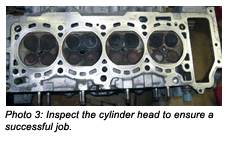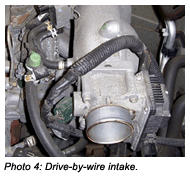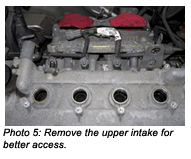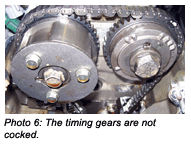This Sentra is equipped with the QG18DE 1.8L
4-cylinder powerplant. Outfitted with twin cams, four valves per cylinder and chain-driven variable valve timing, I certainly don’t recommend just diving in and taking stuff apart. While not a difficult job, it pays real dividends to consult your service information before putting a wrench to any engine.
SERVICE PROCEDURES
In the case of this Sentra, precautions are required for both the camshaft gears as well as the timing chain tensioner.

The first step after disconnecting the battery is to drain the coolant from both the radiator and the engine. I always like to drain the block, if possible. It just makes sense to prevent coolant from getting in the engine and it goes a long way in keeping the work area clean.
The next step involves removing the air intake ducting. In this case, the intake manifold would be removed with the head, but we found access was better with the upper plenum removed. Don’t forget the intake manifold rear supports. The exhaust manifold does have to come off.
With the cam and front cover removed, it’s time to review the service info and remove the camshafts.  The first step is to bring the engine up to TDC. Always turning in the direction of rotation (clockwise), confirm that the timing marks are aligned and make your own marks on the chain to be used on reassembly.
The first step is to bring the engine up to TDC. Always turning in the direction of rotation (clockwise), confirm that the timing marks are aligned and make your own marks on the chain to be used on reassembly.
Now it’s time to prepare the timing gears for removal. Nissan, like most manufacturers, uses oil pressure to adjust the cam timing. The intake cam is at the most retarded position when the engine is off and has to be locked in the most advanced position for removal. Nissan uses an internal lock pin in the pulley that has to be released, so you can put the cam in the advanced position and lock it there.
Apply air pressure to the rear most oil port in the head where the valve timing control solenoid mounts. Listening closely, you can hear the internal pin disengage in the sprocket. Keeping the air applied, turn the cam clockwise with an open-end wrench on the hex part of the cam. Don’t force it; if the pin is released, the cam won’t be hard to turn. If necessary, “wiggle” the cam to dislodge the pin; the most stubborn cases may require some easy taps with a plastic hammer on the face of the gear.
You’ll know you’re at the most advanced position when the sprocket starts to move with the cam. At this point, insert a locking pin in the sprocket to lock the gear in the most advanced position. Your service information will describe the pin that’s required, but it’s basically an Allen wrench. Tape the pin in place to be sure it stays put.
Now the timing chain tensioner can be removed. The tensioner is a ratchet type; to release the ratchet, push down the release lever allowing you to push the plunger into body. At that point, insert a stiff wire through the lever into the tensioner housing to lock the release and plunger in place. Skip this step and you have a good chance of the plunger and spring ending up in the oil pan.
Now we can remove the cam sprockets. Again holding the cams with a wrench on the hex section of the shaft, remove the bolts that secure the gears to the cams.
Now the camshafts can be removed and we can get to the head bolts; again refer to the service information for the recommended removal sequence of the cam cap and head bolts. Make note of the cam cap bolts; they’re color-coded to ensure they go back where they belong. Be sure to mark the cam followers as they’re removed. Nissan uses shim-type adjusters on this engine, and to maintain the proper clearance, it’s critical that the lifters go back in the same location.

It’s a good habit to check the valve lash before the camshafts are removed, as this is the best time to change a shim if it’s necessary. Valve lash will also give us an indication of the valve condition. If you find lash that has tightened up, it’s a pretty good indication that some wear has taken place between the face of the valve and the seat. With the cylinder head already coming off, it might make sense to have the valves serviced. Of course, this is a different job than a simple gasket replacement and the estimate will need to be updated and approved.
With the cams out of the way, the head bolts can be accessed and removed; do so in a couple of steps and it can’t hurt to follow the recommended loosening sequence in your service information.

Now that the head is off and on the bench, it’s time to do some inspections to ensure a successful job. In our case, we were concerned that the head may have warped as a result of the overheating. Using a straight edge, the head checked within the 0.003 tolerance, so we’re good with a simple gasket replacement. We were confident that a gasket replacement was going to take care of our problem with the distortion evident on the original gasket. Unfortunately, it didn’t photograph well, but the damage was apparent.


